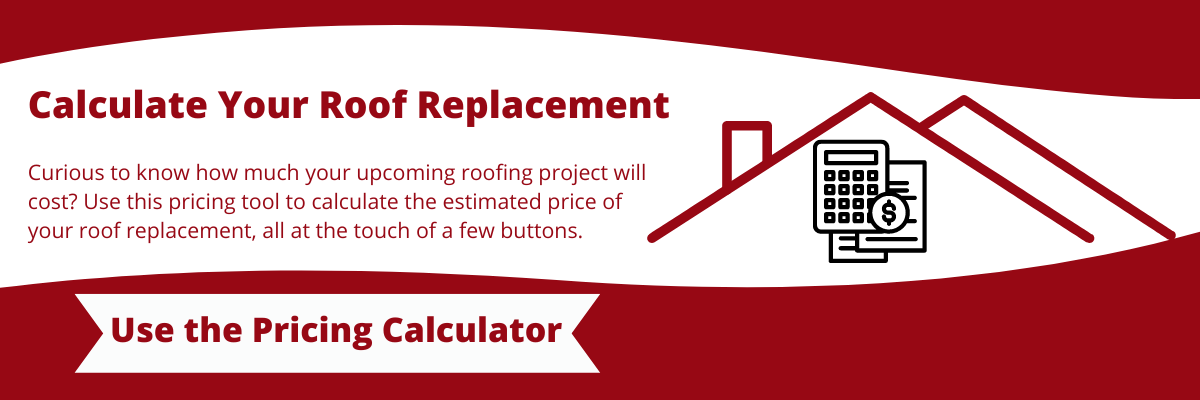Metal Shingles vs. Standing Seam: Which is the Better Choice for Your Roof?
March , 2023 | 16 min. read
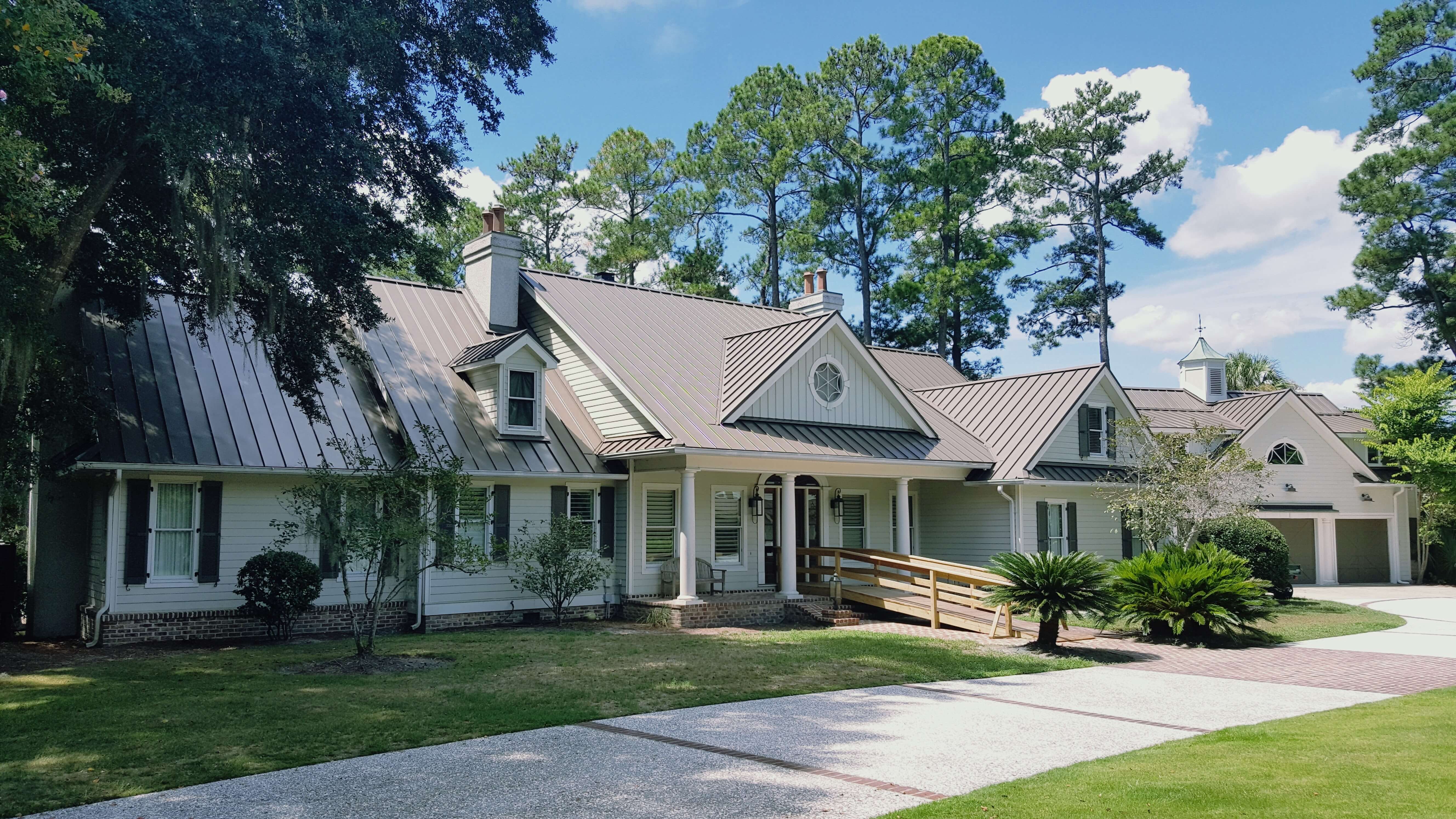
Scrolling through pages of information and feeling more confused than ever?
Are you feeling overwhelmed with all the options available for your upcoming metal roof investment?
We get it. Don't worry, we've got you covered!
At RoofCrafters, we understand that choosing the right metal roofing system for your home can be a daunting task. With over 30 years of experience in the roofing industry, we've seen it all, from DIY disasters to questionable contractor choices. But fear not, dear reader, because we're here to share our 3 decades of expertise with you.
In this ultimate guide, we'll be comparing Metal Shingles Vs Standing Seam Metal to help you understand the pros, cons, and costs of each option. And hopefully, by the end of this article, you'll have the knowledge to confidently choose the best metal roofing system for your home.
Let's dive right in!
Understanding Metal Roofing: Exploring Metal Shingles and Standing Seam Metal Roofs
Metal roofing is becoming popular due to its durability, longevity, and energy efficiency. Metal roofs come from various materials. The most popular metals and what we'll be covering are aluminum, steel, and galvalume.
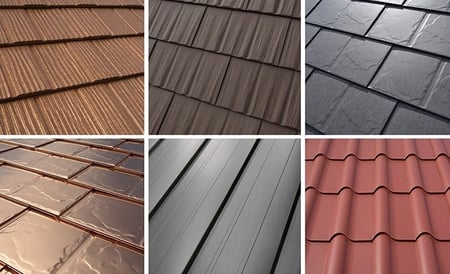
Metal roofing also comes in a wide variety of colors making it easy to pick the perfect shade for your home. In this next section, we'll focus on two popular styles of metal roofing:
- Metal shingles
- Standing seam roofs
Let's start by discussing metal shingles.
Metal Roofing Shingles
A metal shingle roof is a type of metal roofing that mimics the appearance of traditional shingles. While providing the many benefits of metal roofing. They're individual interlocking shingles. Most styles are installed with hidden fasteners. Which helps provide excellent protection against the elements. Like other metal roofing systems, metal shingles are durable, energy-efficient, and low maintenance.
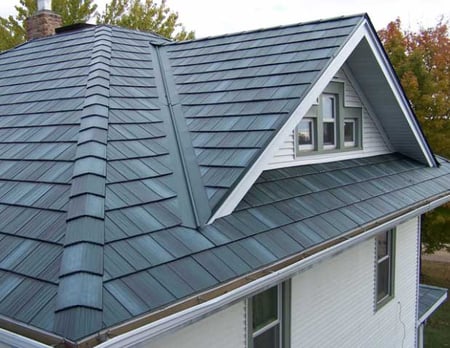
Metal shingles come from high-quality aluminum, steel, or galvalume. They're available in a wide variety of styles and colors. Specially designed to interlock and fasten together to provide a weather-tight roof.
Styles and Options for Metal Shingles
Metal shingles are available in a variety of styles and colors. As mentioned they're designed to mimic the appearance of traditional roofing materials. Like asphalt shingles, slate, cedar shakes, or tile.
The most popular styles of metal shingles include:
- Shake roof: Metal shake shingles can replicate the look of natural cedar shakes with their rugged texture and split edges.
- Slate roof: Metal slate shingles mimic the look of natural slate with their distinctive texture and color variations.
- Tile roof: Metal tile shingles can provide the look of traditional tiles. With a curved shape and barrel design or flat concrete tile roof.
- Shingle roofs: Metal shingle roofs can replicate the appearance of asphalt shingles. Adding durability and longevity of metal.
- Victorian roofs: Individual metal shingles that provide a vintage look. This design comes from the Victorian era.
Before deciding, if one of the metal shingles is right for your home. We always recommend reviewing any disadvantages.
Cons of Metal Shingles: Factors to Consider Before Investing
Some potential cons or downsides of a metal shingle roof include:
- Cost: Metal shingles can be more expensive than traditional asphalt shingles.
- Noise: Like any metal roofing system, metal shingles can be noisy during heavy rain or hail storms.
- Denting: Metal shingles can dent if hit by hail or other heavy objects, which can impact their aesthetic appeal.
- Installation: The installation of metal shingles is more complex than traditional roofing materials. Which can increase installation costs.
- Color fading: Over time, the color of metal shingles can fade due to exposure to the sun and other weather elements.
- Assessability: Due to the interlocking nature of metal shingles, it can be more difficult to walk on the roof for maintenance or repair purposes. This can increase the cost of maintenance or make it more difficult to perform.
- Availability: Depending on the region you live in. Certain styles or colors of metal shingles may not be available, limiting your options.
- Expansion and contraction: Metal shingles can expand and contract with temperature changes. Like all metal roofs. Which can cause fasteners to loosen or panels to shift over time. This can impact the integrity and lifespan of the roof if not installed correctly.
Pros of Metal Shingles as a Roofing Option
Every product has downsides. The same products also provide many advantages. Some of the potential pros of a metal shingle roof include:
- Durability: Metal shingles are durable and can last up to 50 years or more with proper maintenance.
- Weather-resistant: Metal shingles can withstand harsh weather conditions, including wind, rain, and snow.
- Energy-efficient: Metal shingles can help reflect heat from the sun. This reduces energy consumption and cooling costs.
- Low maintenance: Metal shingles are relatively low maintenance. Requiring little upkeep over their lifespan.
- Aesthetic appeal: Metal shingles can provide a beautiful look. Added curb appeal is one of the main benefits of metal shingles.
- Lightweight: Metal shingles are lightweight. This will reduce stress on the roof structure and extend its lifespan.
- Fire-resistant: Metal shingles are fire-resistant, providing an added level of safety to your home.
- Environmentally friendly: Metal shingles can be recycled at the end of their lifespan.
- Increased home value: A metal shingle roof can add value to your home and increase its curb appeal. Making it more attractive while you live there and to potential buyers when it's time to sell.
Now that you know the pros, cons, and styles of metal shingles. Let's discuss standing seam metal options.
Standing Seam Metal Roofing
A standing seam roof is a type of metal roofing system characterized by raised interlocking seams that join adjacent panels. The panels run vertically from the roof ridge down to the eaves. Each panel locking into place with the adjacent panel using concealed fasteners. The seams of the panels are raised and standing. This is how the roof got its name.
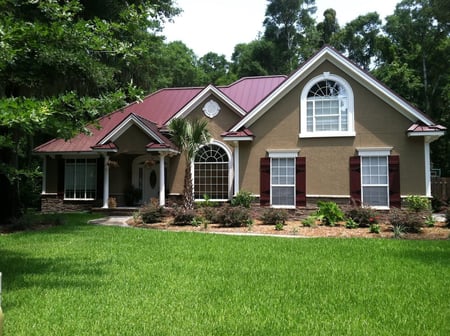
Standing seam roofs are available in a variety of materials, including aluminum, steel, and galvalume. Known for their durability, longevity, and weather resistance. They come in a variety of colored paint finishes with warranties. Along with different panel profiles.
They're most often used in commercial and higher-end residential homes.
The seams on the standing seam roof come in a variety of heights and profiles. The type of seam can change the installation method and provide a unique look. Here are the seam types:
- Snap-lock: This is the most common profile for standing seam metal roofs. The panels have a snap-lock design that interlocks with adjacent panels, creating a secure seam.
- Mechanical-lock: This profile has a similar design to the snap-lock but with a mechanically seamed seam. The panels are crimped together with a machine, creating a stronger connection.
- Batten seam: This profile features a raised seam that is held in place by vertical battens. It provides a traditional, classic look to the roof.
- Nail-strip: This profile uses a nail strip to secure the panels, with the seam folding over the strip to create a watertight seal.
- T-seam: This profile features a raised seam that is folded over to create a "T" shape. It provides a unique, modern look to the roof.
These styles can vary in appearance, seam height, and installation method. This allows for a range of customization options. However, the most common seams are Snap-lock and Mechanical-lock.
Different Panel Profiles of Standing Seam Metal Roofing
Standing seam metal roofing is a popular choice for many homeowners due to its durability, longevity, and modern aesthetic. The roofing panels come in a variety of profiles, each with unique features and benefits. Here are some of the most common profiles of standing seam metal roofing:
- Flat Panel: The traditional flat panel is a smooth panel without any ribs or striations. It's a simple and clean look that works well for modern and contemporary homes.
- Striated panel: This profile has a slight ribbed or grooved texture that adds dimension and interest to the roof. It's a popular choice for residential and commercial buildings.
- Pencil rib panel: This panel profile has a narrow raised rib that runs the length of the panel. This style is typically used for decorative purposes to give the roof more character as well as strengthen the panel.
- Stiffening rib panel: This profile has larger raised ribs that provide added strength and rigidity to the roof. This style is commonly used for industrial buildings. Yet it can also be used for residential applications in areas with heavy snow loads or other weather concerns.
Let's discuss the cons of standing seam.
Potential Drawbacks of Standing Seam Metal Roofs
Here are some potential cons of a standing seam metal roof:
- Cost: Standing seam metal roofs can be more expensive than other roofing materials, such as asphalt shingles.
- Oil canning: Oil canning is a distortion of the aesthetic of the metal and often looks wavy.
- Installation: Installation of a standing seam metal roof requires special equipment and expertise. This will increase the cost and time of installation.
- Noise: Although some homeowners appreciate the sound of rain on a metal roof. You may find it loud and disruptive during heavy rainfall or hailstorms.
- Maintenance: Metal roofs are generally low-maintenance. Standing seam roofs may need periodic inspection and maintenance. This is to ensure the integrity of the pipe penetrations and flashing sealants to prevent leaks.
- Expansion and contraction: Metal expands and contracts with temperature changes. This can cause the sealants and fasteners to loosen over time and need repair.
- Scratches: Metal roofs can be prone to scratches and dings from falling debris. This can be more noticeable on a standing seam roof than on other styles.
Now that you know the cons let's discuss the pros of standing seam roofing.
Benefits of Choosing a Standing Seam Metal Roof
Some of the pros and advantages of a standing seam metal roof include:
- Durability: Standing seam metal roofs are extremely durable and can last for 50+ years or more with proper maintenance.
- Energy efficiency: The reflective properties of metal roofs can help to reduce cooling costs in warm climates. By reflecting sunlight and reducing heat absorption.
- Weather resistance: Metal roofs can withstand extreme weather conditions such as heavy rain, snow, and high winds.
- Low maintenance: Standing seam metal roofs need very little maintenance over their lifespan. This can save you time and money in the long run.
- Sustainability: Metal roofs are a sustainable option since they can be recycled at the end of their lifespan.
- Resistant to pests and rodents: Standing seam will keep the bugs out. the rodents will not tear up this roofing material as they do with asphalt shingles.
- Curb appeal: Standing seam metal roofs can enhance the curb appeal of a home and add value to the property. Because metal is in high demand, this will increase your home's resale value.
- Fire resistance: Metal roofs are fire-resistant and can provide an extra layer of protection for your safety.
- Environmentally friendly: Metal roofs are 100% recyclable. Making them a sustainable choice for homeowners who are looking to reduce their carbon footprint.
- Long lifespan: Standing seam metal roofs can last 50 years or more with minor maintenance. Providing you with a long-lasting investment.
- Warranty: Standing seam metal roofs come with long warranties. This will provide you with peace of mind for many years to come.
Now that you've learned about the seams and profiles of standing seam metal. You also know the potential drawbacks and benefits. So let’s discuss the elephant in the room...the cost!
The Cost of the Top 7 Types of Metal Used for Roofing
Copper, lead, zinc, and terne metal are rare metals. So because they’re rare metals, the cost is often much greater. Therefore they're used less often too. But to be fair, we still wanted to provide you with the average pricing for your consideration.
- Copper metal roof - average cost is 22.33 to 31.18 per square foot
- Lead metal roof - average cost is 19.78 to 28.51 per square foot
- Zinc metal roof - average cost is 18.63 to 26.97 per square foot
- Terne metal roof - average cost is 17.25 to 24.43 per square foot
- Aluminum metal roof - average cost is 13.92 to 19.77 per square foot
- Steel metal roof - average cost is 9.52 to 18.90 per square foot
- Galvalume metal roof - average cost is 8.22 to 17.89 per square foot
Now, in this next section, we'll discuss the cost of the most popular metals used for roofing. Which are aluminum, steel, and galvalume.
The Cost of Standing Seam Metal Roofing Installing Aluminum, Steel, or Galvalume
Here are examples of homes with each of the 3 types of standing seam metal roofing:
- Aluminum
- Steel
- Galvalume
Aluminum Standing Seam Roof Cost
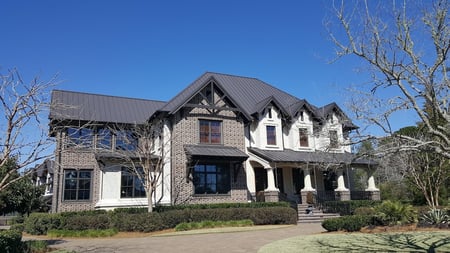
An aluminum standing seam metal roof on a house with 2 or 3 stories. On a complex roofline, with a chimney, walls, and several valleys. The average cost is $82,300.
Steel Standing Seam Roof Cost
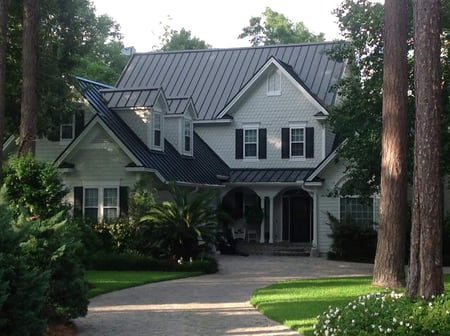
A steel standing seam metal roof on a house with 2 or 3 stories. More complex roofline, with walls, and several valleys. The average cost is $58,700.
Galvalume Standing Seam roof Cost
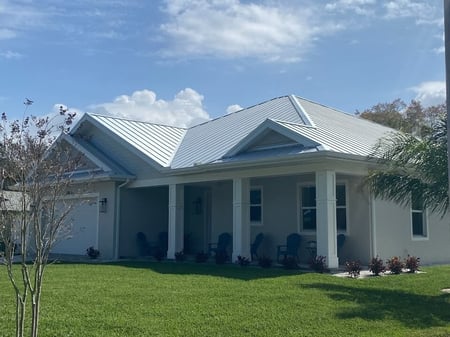
A galvalume standing seam metal roof on 1 story home. Standard roofline, with walls, hips, and valleys. The average cost is $46,200.
The Cost of Metal Shingles with Different Profiles and Styles
Here are some examples of a metal shingle using the following metal shingles styles:
- Traditional metal shingles
- Metal slate roofing
- Metal wood shakes
- Metal Spanish tile
- Victorian metal shingle
Traditional Metal Shingle Roof Cost
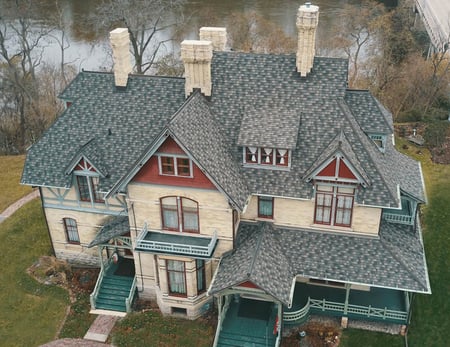
For a large home with a very complex roofline, the average cost with metal shingles using the Decra Shingle HD is $91,000
Metal Slate Roof Cost
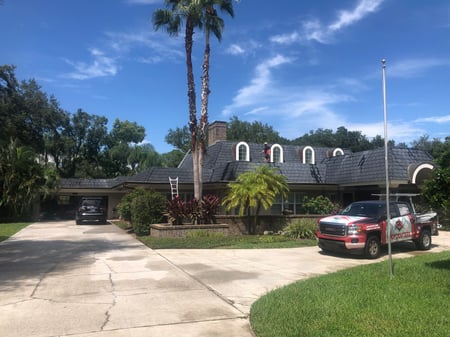
For a larger home with a complex roofline, the average cost of using metal slate shingles is $85,000
Metal Shake Roof Cost
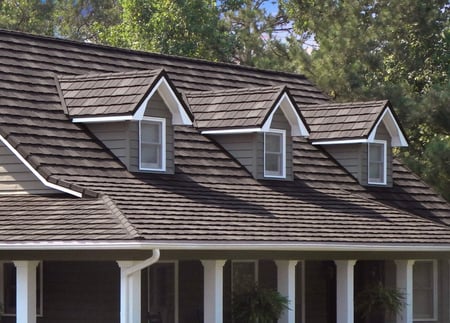
To install the Decra Metal Shake HD on an average size home with a standard roofline that has a few dormers. The average cost is $81,000
Metal Tile Roof Cost
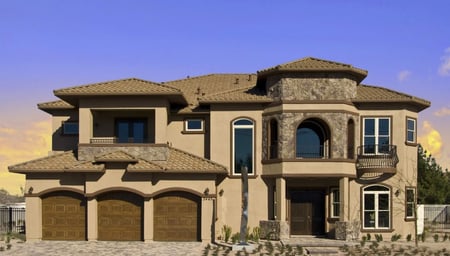
To install a Decra metal Villa Tile on a larger home with a complex roofline. The average cost is $87,000
Victorian Metal Shingle Cost
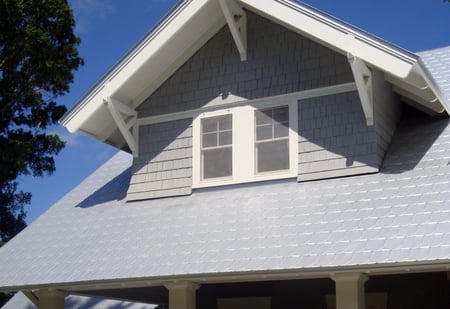
To install a victorian style metal shingle on an average size home with a standard roofline The average cost is $73,000
Ready to Discuss Metal Roofing Options With a Professional?
Now that you learned the pros, cons, and costs of metal shingles and standing seam roofing. You're probably ready to discuss your options. We recommend that you get multiple quotes from trustworthy roofing companies. You want to find someone you'll want to work with and who'll provide the best value for your budget.
Our family at Roofcrafters has been providing high-quality metal roof installations for 3 decades. If you live in one of our service areas in South Carolina, Georgia, or Florida, we'd love to come out and discuss all the metal roof replacement options for your upcoming project.
At RoofCrafters, our mission is to provide job opportunities for others to thrive and grow while making a meaningful impact within our communities.


